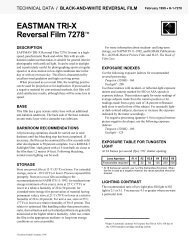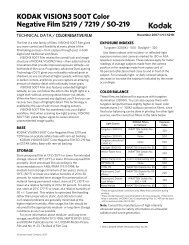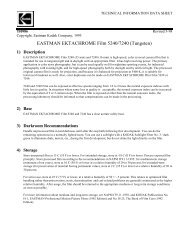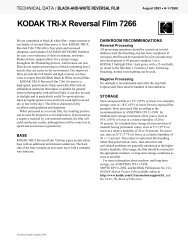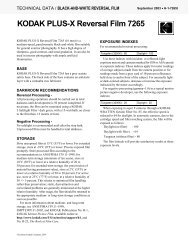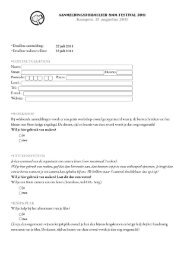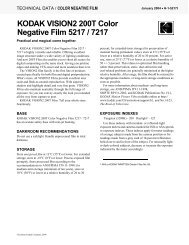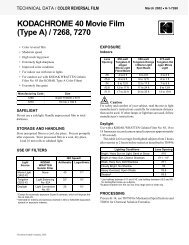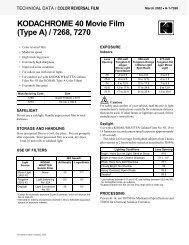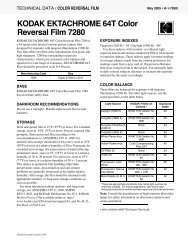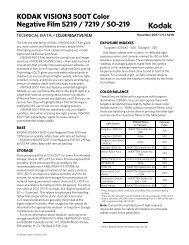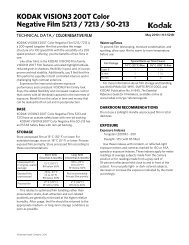FUJICHROME ASTIA 100F Professional [RAP100F] - Wittner ...
FUJICHROME ASTIA 100F Professional [RAP100F] - Wittner ...
FUJICHROME ASTIA 100F Professional [RAP100F] - Wittner ...
You also want an ePaper? Increase the reach of your titles
YUMPU automatically turns print PDFs into web optimized ePapers that Google loves.
AF3-149E<br />
COLOR REVERSAL FILMS<br />
<strong>FUJICHROME</strong> <strong>ASTIA</strong> <strong>100F</strong> <strong>Professional</strong> [RAP<strong>100F</strong>]<br />
1. FEATURES AND USES<br />
<strong>FUJICHROME</strong> <strong>ASTIA</strong> <strong>100F</strong> <strong>Professional</strong> [RAP<strong>100F</strong>] is<br />
an ISO 100 daylight-type color reversal film for professional<br />
use. This film boasts smooth and natural skin<br />
tone reproduction from the highlights to the shadows<br />
and exceptionally fine grain of RMS* granularity 7.<br />
These characteristics provide the film with one of the<br />
world’s highest levels of color fidelity, making it ideally<br />
suited for fashion photography and portraiture that demand<br />
exquisite skin tones and faithful costume rendition.<br />
Features<br />
• Excellent<br />
Skin Tone<br />
Reproduction<br />
• Superb Color<br />
Fidelity<br />
• Exceptionally<br />
Fine Grain<br />
of RMS<br />
Granularity 7<br />
• Improved Color<br />
Image Stability<br />
• Excellent Push-/<br />
Pull-processing<br />
Suitability<br />
• Softest tones and subdued<br />
colors among <strong>FUJICHROME</strong><br />
films, enabling skin tones to<br />
be reproduced with smooth<br />
and naturally continuous<br />
gradation from the highlights<br />
to the shadows<br />
• MCCL (Multi-Color-Correction<br />
Layer) technology and<br />
new color materials that give<br />
this film one of the world’s<br />
highest levels of color fidelity<br />
ideal for the reproduction of<br />
costumes, accessories and<br />
other subtly colored subjects<br />
• Exceptionally fine grain for a<br />
reversal film (RMS granularity<br />
value 7), making this film<br />
perfect for the depiction of<br />
smoother skin tones<br />
• New couplers incorporated<br />
for sharply improved color<br />
image stability (anti-fading<br />
characteristics) compared<br />
with existing reversal films<br />
• Push-/Pull-processing from<br />
-1/2 stop up to +2 stops with<br />
minimal changes in color<br />
balance and gradation,<br />
allowing easy and precise<br />
correction of exposure and<br />
density, and providing<br />
support for a wide range of<br />
shooting situations<br />
* RMS stands for “Root Mean Square”, a widely used standard<br />
method for measuring the degree of grain in photographic film.<br />
The lower the RMS number, the smaller the apparent grain.<br />
2. SPEED<br />
Light Source Speed Filter<br />
Daylight ISO 100/21° None<br />
Tungsten Lamps<br />
No.80A**<br />
ISO 32/16°*<br />
(3200K)<br />
(LBB-12***)<br />
* Indicates the effective speed resulting from designated filter use.<br />
** Wratten Filter<br />
*** Fuji Light Balancing Filter (not available in certain markets.)<br />
3. FILM SIZES, EMULSION NUMBER,<br />
BASE MATERIAL AND THICKNESS<br />
Sizes<br />
• Rolls*<br />
135 .... 36-exp.<br />
.... 36-exp. (5-roll and<br />
20-roll packs)<br />
35 mm × 30.5 m (100 ft.)<br />
120 .... 12-exp.<br />
.... 12-exp. (5-roll packs)<br />
220 .... 24-exp. (5-roll packs)<br />
• Sheets*<br />
4 × 5 in. (10.2 × 12.7 cm)<br />
.... 10 sheets and 50 sheets<br />
8 × 10 in. (20.3 × 25.4 cm)<br />
........................... 10 sheets<br />
QuickLoad 4 × 5 in. .. 20 sheets<br />
Emulsion<br />
Number<br />
#601 –<br />
Base<br />
Material<br />
Cellulose<br />
Triacetate<br />
Polyester<br />
* Some sizes are not available in certain markets.<br />
Light<br />
Conditions<br />
Seashore or<br />
Snow Scenes<br />
under Bright<br />
Sun<br />
Bright<br />
Sunlight<br />
Hazy<br />
Sunlight<br />
Cloudy<br />
Bright<br />
Base<br />
Thickness<br />
127 µm<br />
98 µm<br />
175 µm<br />
4. EXPOSURE GUIDE FOR VARIOUS<br />
LIGHT CONDITIONS<br />
Use a meter for exposure determination. If a meter is not<br />
available, refer to the following table.<br />
Cloudy<br />
Day or<br />
Open<br />
Shade<br />
Lens<br />
f/16 f/11 f/8 f/5.6 f/4<br />
Aperture<br />
(Exposure time: 1/250 sec.)<br />
NOTES<br />
• The foregoing settings are for 2 hours after sunrise and 2 hours<br />
before sunset.<br />
• Provide a lens opening 1/2-stop smaller during the summer<br />
and 1/2-stop larger during the winter (except for snow scenes).<br />
• Excessively bright (or dark) or backlighted subjects may require<br />
plus (or minus) 1-stop lens opening adjustments.<br />
Daylight<br />
Under normal daylight conditions, color balancing filters<br />
are not necessary, but the following exposure conditions<br />
may require the indicated filters.<br />
– 1 –
FUJIFILM PRODUCT INFORMATION BULLETIN • <strong>FUJICHROME</strong> <strong>ASTIA</strong> <strong>100F</strong> <strong>Professional</strong> [RAP<strong>100F</strong>]<br />
• A UV filter No. 2C* (SC-39 or SC-40)** or other appropriate<br />
ultraviolet absorbing filter is recommended<br />
for scenes that are shone upon by strong<br />
ultraviolet light, such as seaside locations, snow<br />
scenes, and bright distant views.<br />
• Excessively high or low color temperatures may require<br />
the following filters and exposure corrections.<br />
Subject Conditions<br />
High Color Temperature:<br />
Cloudy weather landscapes or<br />
portraits in open shade in clear<br />
weather.<br />
Low Color Temperature:<br />
Morning and evening twilight<br />
scenes and portraits.<br />
Filter<br />
No.81A*<br />
(LBA-2)***<br />
No.82A* or<br />
No.82C* (LBB-2<br />
or LBB-4)***<br />
Exposure<br />
Correction<br />
+1/3<br />
stop****<br />
+1/3 to<br />
+2/3<br />
stop****<br />
* Wratten Filter<br />
** Fuji Sharp-cut Filter<br />
*** Fuji Light Balancing Filter (not available in certain markets.)<br />
**** A “+” followed by a number indicates the required increase in<br />
lens opening.<br />
Electronic Flash<br />
• Electronic flash produces light similar to daylight, so<br />
filters are not needed. However, the possibility of undesirable<br />
effects on color balance, due to various<br />
factors (differences in equipment, use duration, etc.)<br />
should be taken into consideration. Test exposures<br />
are recommended.<br />
• The use of a flash meter is advisable, but the following<br />
formula can also be used to obtain a satisfactory<br />
lens opening.<br />
Lens<br />
Electronic Flash Guide Number (at ISO 100)<br />
Aperture =<br />
(F-number) Electronic Flash-to-Subject Distance (meters or feet)<br />
• Set the film speed at ISO 100. Since the amount of<br />
light reflected onto the subject from surrounding surfaces<br />
will differ with the conditions, refer to the flash<br />
unit instructions.<br />
Daylight Photoflood / Photo-Reflector Lamps<br />
• Daylight-type photoflood or photo-reflector lamp output<br />
may be lower than that indicated by an exposure<br />
meter, so it is advisable to compensate for this by increasing<br />
exposure time or lens opening. Whenever<br />
possible, test exposures are recommended.<br />
• Other factors requiring consideration when determining<br />
the exposure time are lamp configuration, use<br />
duration and line voltage, as they may affect lamp<br />
output and color balance<br />
Fluorescent Lamps<br />
• The use of the following combinations of color compensating<br />
filters is advisable when photographing<br />
under fluorescent lighting.<br />
• For exacting work, however, test exposures are recommended<br />
because lamp brand and age may affect<br />
light output and color balance.<br />
– 2 –<br />
Fluorescent<br />
Lamp Type<br />
Color<br />
Compensating<br />
Filters*<br />
Exposure<br />
Corrections**<br />
White<br />
(W)<br />
10B+5M<br />
+1/2 stop<br />
Daylight<br />
(D)<br />
25R<br />
+1 stop<br />
Cool White<br />
(CW)<br />
15M+5B<br />
+2/3 stop<br />
Warm White<br />
(WW)<br />
No. 80C+10M<br />
+1 stop<br />
(Exposure time: 1/2 sec.)<br />
* Wratten Color Compensating Filters or Fuji Color Compensating<br />
Filters are recommended.<br />
NOTE: No. 80C is a Wratten Color Conversion Filter.<br />
** Exposure correction values when using a filter relative to unfiltered<br />
exposure results. A “+” followed by a number indicates the<br />
required increase in lens opening.<br />
NOTES<br />
• Use a shutter speed slower than 1/30 second.<br />
• For shutter speeds of 2 minutes or more, exposure adjustments<br />
will be necessary to compensate for reciprocity law failure.<br />
Tungsten Lamps<br />
• A Wratten Filter No.80A (or Fuji Light Balancing Filter<br />
LBB-12) is required when using 3200K tungsten lighting.<br />
A 1 2 /3-stop larger lens opening is also required.<br />
• If household tungsten lighting (room lamps, etc.)<br />
constitutes the main source of illumination, in addition<br />
to the above filter a Wratten Filter No.82A (or Fuji<br />
Light Balancing Filter LBB-2) is required, plus an aperture<br />
increase of 1/3 stop (total 2 stops).<br />
Mixed Light Sources<br />
Under mixed light conditions, the basic filter configuration<br />
should suit the main light source. In the case of<br />
cameras with TTL metering, there is no need for additional<br />
exposure compensation for any CC filter(s) used.<br />
5. LONG AND MULTIPLE EXPOSURE<br />
COMPENSATION<br />
No exposure correction or color balance compensation<br />
is required for exposures within a shutter speed range of<br />
1/4000 second to 1 minute. However, for exposures of 2<br />
minutes or longer, ‘reciprocity law failure’-related color<br />
balance and exposure compensations are required.<br />
Exposure Time 1/4000 sec. – 1 min.<br />
Color Compensating<br />
Filter<br />
None<br />
Exposure<br />
Corrections*<br />
2 min.<br />
5B<br />
+ 1/3<br />
stop<br />
4 min.<br />
5B<br />
+ 1/2<br />
stop<br />
8 min.<br />
5B<br />
+ 2/3<br />
stop<br />
* Exposure correction values when using a filter relative to unfiltered<br />
exposure results. A “+” followed by a number indicates the required<br />
increase in the lens opening.<br />
Multiple Exposures<br />
No exposure correction or color balance compensation<br />
is required for up to eight consecutive multiple exposures<br />
using an electronic flash.<br />
NOTE<br />
Exposure correction values given above for long and<br />
multiple exposures are for a reversal film with an average<br />
emulsion when processed under standard processing<br />
conditions. Therefore, use the data only as a<br />
guide. For exacting work, test exposures are recommended<br />
under actual shooting conditions.
<strong>FUJICHROME</strong> <strong>ASTIA</strong> <strong>100F</strong> <strong>Professional</strong> [RAP<strong>100F</strong>] • FUJIFILM PRODUCT INFORMATION BULLETIN<br />
6. EXPOSURE PRECAUTIONS<br />
With artificial light, such as electronic flash, photoflood,<br />
fluorescent, tungsten, high intensity discharge lamp<br />
(metal halide, sodium, mercury vapor), etc., the lamp<br />
output and color temperature may be affected by such<br />
factors as brand, age of equipment and line voltage.<br />
Reflectors and diffusers can also influence light intensity<br />
and color temperature.<br />
7. FILM HANDLING<br />
• Expose film before the expiration date indicated on<br />
the film package and process as soon as possible<br />
after exposure.<br />
• When loading and unloading roll film, avoid direct<br />
sunlight. If there is no shade, shield the film from the<br />
sun with your body.<br />
• Camera-loaded film should be exposed and processed<br />
immediately.<br />
• Handle sheet film in total darkness. Avoid touching<br />
the emulsion surface. (The use of a safelight will<br />
cause fogging.)<br />
• At airport and other terminals, unprocessed film<br />
should be kept away from X-rays used to inspect<br />
checked-in baggage. Strong X-rays can cause fogging<br />
of unprocessed film. Always place such film in<br />
your carry-on baggage. (It is recommended that film<br />
be placed in transparent plastic bags or net bags<br />
through which the film is visible.) Film which may be<br />
subjected to multiple X-ray inspections should be removed<br />
from carry-on baggage for visual (manual) inspection<br />
instead.<br />
• Film fogging may occur near X-ray equipment used<br />
in hospitals, factories, laboratories and other locations.<br />
Always keep film away from possible sources<br />
of radiation.<br />
8. FILM STORAGE<br />
Unprocessed Film<br />
• Storing exposed or unexposed film under hot and humid<br />
conditions may adversely affect the speed, color<br />
balance and physical properties of the film. Store<br />
film under the following conditions.<br />
⎧<br />
⎪<br />
⎨<br />
⎪<br />
⎩<br />
Ï Short-to-medium-term Storage:<br />
Below 15°C (59°F) ...... (Refrigerator)<br />
Ï Long-term Storage:<br />
Below 0°C (32°F) ........ (Freezer)<br />
• Building materials, finishes used on newly manufactured<br />
furniture, paints and bonding agents may produce<br />
gases which could affect photographic film. Do<br />
not store film, lightproof boxes of film, loaded cameras<br />
or film holders near these materials.<br />
• Before use, films taken from cold storage should be<br />
allowed to stand at room temperature for over 3<br />
hours for refrigerated film, and over 6 hours for frozen<br />
film. Long rolls such as 100 feet (30.5 m) will require<br />
additional time. Opening a package/box of film that<br />
is cold may cause harmful condensation.<br />
Processed Film<br />
As with materials used in other products, the materials<br />
used in photographic products will change over time.<br />
Since film is usually used for the long-term recording of<br />
memorable events, as much effort as possible is made<br />
to use materials that exhibit the least amount of change<br />
over time, but the effects of light, heat, oxygen in the air,<br />
contaminating gases, humidity and mold cannot be<br />
completely avoided. It is possible, however, to minimize<br />
the change in the photographic image or base material *1<br />
by maintaining the appropriate storage conditions for<br />
films, such as those used by museums and art galleries.<br />
Temperature and humidity control is the most important<br />
key to minimizing the change that occurs in film. Films<br />
stored in the dark under the following conditions *2 may<br />
be expected to show almost no change over time.<br />
⎧<br />
⎪<br />
⎪<br />
⎨<br />
⎪<br />
⎪<br />
⎩<br />
Ï<br />
Ï<br />
Storage Period with Almost No Change:<br />
More than 20 years, Temperature: Below 10°C,<br />
Relative Humidity: 30% – 50%<br />
Storage Period with Almost No Change:<br />
10 – 20 years, Temperature: Below 25°C,<br />
Relative Humidity: 30% – 50%<br />
*1 Changes in the photographic image or base material generally<br />
take the form of reduced image quality (color fading). In<br />
some cases, however, damage to the base material may be<br />
caused by chemical changes that occur in the product when<br />
placed in a closed environment under hot and humid conditions.<br />
*2 For the conditions indicated above, a well-ventilated place is<br />
the ideal; however, since containers prevent the passage of<br />
air, it is recommended that films be removed from containers<br />
and ventilated about once a year. Ventilation should be done<br />
during seasons in which the air is dry. Color reversal film<br />
should either be mounted or inserted into sleeves.<br />
9. PROCESSING<br />
This film is designed for processing by Kodak Process<br />
E-6, or Fujifilm Process CR-56, etc.<br />
10. LIGHT SOURCES FOR VIEWING<br />
Use a standard transparency viewer. Visual responses<br />
will differ with light source quality and brightness.<br />
Therefore, employ a viewer which meets the ISO/ANSI<br />
standard.<br />
* The ISO standard (ISO/DP3664-2) specifies an illuminated<br />
viewer surface with a color temperature derived from a CIE<br />
illuminant D50 (D:Daylight) with a reciprocal color temperature<br />
of 5000K, an average brightness of 1400cd/m² ± 300cd/m², a<br />
brightness uniformity of more than 75%, a light diffusion level<br />
of more than 90% and an average color rendition assessment<br />
value of more than Ra90. Transparency viewers should meet<br />
these standards.<br />
– 3 –
FUJIFILM PRODUCT INFORMATION BULLETIN • <strong>FUJICHROME</strong> <strong>ASTIA</strong> <strong>100F</strong> <strong>Professional</strong> [RAP<strong>100F</strong>]<br />
11. PRINTS AND DUPLICATES<br />
This film can produce high-quality prints when used with<br />
digital printers such as the Fuji Digital Minilab Frontier.<br />
High-quality duplicates can be made on <strong>FUJICHROME</strong><br />
DUPLICATING FILM New CDU TYPE II (New CDU II).<br />
12. RETOUCHING AND BLEACHING<br />
Changes in density and color balance can be made by<br />
using readily available retouching dyes. In regard to<br />
bleaching, this film is more resistant to color dye fading<br />
as compared with existing reversal films, as a result of<br />
its improved color image stability (anti-fading characteristics).<br />
13. PACKAGING<br />
Size Item Contents<br />
135 Film Box New Exclusive Design<br />
Identification Color: Violet Blue<br />
Plastic Case<br />
Cartridge<br />
Same as the current product (Transparent container with a black cap).<br />
New Exclusive Design<br />
Identification Color: Violet Blue<br />
120 Film Box New Exclusive Design<br />
Identification Color: Violet Blue<br />
5-roll pack<br />
Envelope<br />
<strong>ASTIA</strong> <strong>100F</strong> printed on aluminum envelope<br />
– 4 –
<strong>FUJICHROME</strong> <strong>ASTIA</strong> <strong>100F</strong> <strong>Professional</strong> [RAP<strong>100F</strong>] • FUJIFILM PRODUCT INFORMATION BULLETIN<br />
Size Item Contents<br />
120 Backing Paper Backing paper: <strong>FUJICHROME</strong> Exclusive Design<br />
and Seal<br />
Seal: Exclusive Design<br />
Backing Paper<br />
Top Seal<br />
End Seal<br />
220 Film Box New Exclusive Design<br />
Identification Color: Violet Blue<br />
5-roll pack<br />
Envelope<br />
<strong>ASTIA</strong> <strong>100F</strong> printed on aluminum envelope<br />
Backing Paper<br />
and Seal<br />
Backing paper: <strong>FUJICHROME</strong> Exclusive Design<br />
Seal: Exclusive Design<br />
Backing Paper<br />
Top Seal<br />
End Seal<br />
Sheet Film Box, Label New Exclusive Design<br />
and Seal<br />
Identification Color: Violet Blue<br />
14. SHEET FILM CODE NOTCHING<br />
A notch code identifying this emulsion type is located in<br />
the upper right-hand corner when the emulsion surface<br />
is facing toward you. The same notch is provided for<br />
QuickLoad type films.<br />
– 5 –
FUJIFILM PRODUCT INFORMATION BULLETIN • <strong>FUJICHROME</strong> <strong>ASTIA</strong> <strong>100F</strong> <strong>Professional</strong> [RAP<strong>100F</strong>]<br />
15. PROCESSED FILM EDGE MARKINGS*<br />
<br />
• 135 Size<br />
Quality Assurance Code**<br />
Film Designation<br />
Emulsion Number<br />
•35 mm × 30.5 m (100 ft.)<br />
Film Designation<br />
Emulsion Number<br />
• 120 Size<br />
Quality Assurance Code**<br />
Film Designation<br />
Emulsion Number<br />
Quality Assurance<br />
Code**<br />
• 220 Size<br />
Quality Assurance Code**<br />
Film Designation<br />
Emulsion Number<br />
<br />
• Standard Sheet Film<br />
• QuickLoad<br />
* The emulsion is on the opposite side. (Base side facing you)<br />
** This code represents an identification marking enabling Fujufilm’s manufacturing quality control system to assure individual quality.<br />
– 6 –
<strong>FUJICHROME</strong> <strong>ASTIA</strong> <strong>100F</strong> <strong>Professional</strong> [RAP<strong>100F</strong>] • FUJIFILM PRODUCT INFORMATION BULLETIN<br />
16. TECHNOLOGIES INCORPORATED<br />
IN <strong>ASTIA</strong> <strong>100F</strong><br />
16-1 PSHC (Pure, Stable & High-performance<br />
dye-forming Coupler) Technology<br />
The new couplers used in <strong>ASTIA</strong> <strong>100F</strong> provide it with<br />
high color purity, stability and color formation efficiency,<br />
making possible color reproduction with unprecedented<br />
fidelity and excellent image stability.<br />
a) X-Coupler Technology:<br />
This marks the first use in color reversal film of<br />
Fujifilm’s new proprietary cyan coupler.<br />
b) V-Coupler Technology:<br />
New technologies have been incorporated with the<br />
V-coupler applied in Fujifilm’s color papers and other<br />
products to vastly improve color reproduction and<br />
stability. The result is the new magenta coupler that is<br />
incorporated in reversal films for the first time.<br />
c) S-Coupler Technology:<br />
In place of the yellow coupler used in <strong>FUJICHROME</strong><br />
films providing these films with Fujifilm’s trademark<br />
color reproduction and stability, a new yellow coupler<br />
has been incorporated to further boost these characteristics<br />
to even higher levels.<br />
Compared with existing <strong>FUJICHROME</strong> films, the X, V<br />
and S couplers have resulted in a drastic reduction in<br />
auxiliary absorptive components (which cause muddiness)<br />
and provide high color stability.<br />
16-2 MCCL (Multi-Color-Correction Layer)<br />
Technology<br />
Not only has the spectral sensitivity of the three lightsensitive<br />
layers (R, G, B) been optimized, “4th Color<br />
Layer (Green-Color-Correction Layer)” has been incorporated<br />
that performs the “negative spectral sensitivity”<br />
function of the human eye. Additionally, in order to enable<br />
more appropriate color reproduction with a higher<br />
level of fidelity, <strong>ASTIA</strong> <strong>100F</strong> has incorporated MCCL<br />
Technology, as an extension of “4th Color Layer Technology”.<br />
This new technology has provided “Red-Color-<br />
Correction Layer (5th Color Layer)” to enable more faithful<br />
color reproduction and excellent skin tone reproduction.<br />
16-3 MSSC (Multi-Structured Sigma Crystal)<br />
Technology<br />
This technology is incorporated in <strong>ASTIA</strong> <strong>100F</strong> to improve<br />
upon the highly acclaimed ultra-fine grain emulsion<br />
technology used in PROVIA <strong>100F</strong>, resulting in exceptionally<br />
fine grain of RMS granularity 7. This technology<br />
has greatly contributed to faithful color reproduction<br />
and superb skin tone reproduction.<br />
16-4 HTILE (Highly Tuned Inter-Layer Effect)<br />
Technology<br />
Achieving soft, beautiful and smoothly continuous color<br />
gradation in skin tones requires not only smooth gradation,<br />
but also an inter-layer effect that has been exquisitely<br />
adjusted down to the finest details. With <strong>ASTIA</strong><br />
<strong>100F</strong>, clear skin tones with minimal muddiness are produced<br />
by the use of color materials of high purity. The<br />
exquisitely adjusted gradation produced by MSSC<br />
grains enables the reproduction of smooth skin textures,<br />
while the inter-layer effect, which has been precisely<br />
designed and adjusted down to the smallest of<br />
details using computer simulations, makes possible<br />
smoothness in skin tone continuity.<br />
17. FILM STRUCTURE<br />
Protective Layer<br />
Blue Sensitive Layer<br />
(containing Colorless Yellow Coupler)<br />
Yellow Filter Layer*<br />
Green Sensitive Layer<br />
(containing Colorless Magenta Coupler)<br />
Before<br />
Processing<br />
After<br />
Processing<br />
Yellow Positive Image<br />
Magenta Positive Image<br />
Red Sensitive Layer<br />
(containing Colorless Cyan Coupler)<br />
Red-Color-Correction Layer (5th Color Layer)<br />
Green-Color-Correction Layer (4th Color Layer)<br />
Antihalation Layer*<br />
Cyan Positive Image<br />
Safety Film Base<br />
: Silver Halide<br />
: Coupler<br />
: Processing-induced Dye<br />
Backing Layer**<br />
* These layers become colorless and transparent after processing.<br />
** The backing layer becomes colorless and transparent after processing, but it is not provided with 135 size film.<br />
– 7 –
FUJIFILM PRODUCT INFORMATION BULLETIN • <strong>FUJICHROME</strong> <strong>ASTIA</strong> <strong>100F</strong> <strong>Professional</strong> [RAP<strong>100F</strong>]<br />
18. DIFFUSE RMS GRANULARITY VALUE<br />
................. 7<br />
Read at a gross diffuse visual density of 1.0, using a 48-<br />
micrometre aperture.<br />
19. RESOLVING POWER<br />
Chart Contrast 1.6 : 1 .......................... 60 lines/mm<br />
Chart Contrast 1000 : 1 ........................ 140 lines/mm<br />
20. CHARACTERISTIC CURVES 21. SPECTRAL SENSITIVITY CURVES<br />
4.0<br />
3.5<br />
Exposure : Daylight, 1/50 sec<br />
Process : E-6/ CR-56<br />
Densitometry : Fuji FAD-30S (Status A)<br />
1.0<br />
3.0<br />
Density (D)<br />
2.5<br />
2.0<br />
1.5<br />
Sensitivity* (log)<br />
0.0<br />
Blue<br />
Sensitive<br />
Layer<br />
Green<br />
Sensitive<br />
Layer<br />
Red<br />
Sensitive<br />
Layer<br />
1.0<br />
0.5<br />
Red<br />
Green<br />
Blue<br />
–1.0<br />
Process : E-6/ CR-56<br />
Densitometry : Fuji FAD-30S (Status A)<br />
Density : 1.0 above D-min<br />
0.0<br />
-3.0 -2.0 -1.0 0.0 1.0<br />
Exposure [log H (lux-seconds)]<br />
400 500 600 700<br />
Wavelength (nm)<br />
* Sensitivity equals the reciprocal of the exposure<br />
(J/cm²) required to produce a specified density.<br />
22. MTF CURVE 23. SPECTRAL DYE DENSITY CURVES<br />
Response (%)<br />
150<br />
100<br />
70<br />
50<br />
30<br />
20<br />
10<br />
7<br />
5<br />
Exposure : Daylight<br />
3 Process : E-6/ CR-56<br />
2<br />
1 5 10 20 50 100 200<br />
Spatial Frequency (cycles/ mm)<br />
Spectral Diffuse Density<br />
1.0<br />
0.5<br />
0.0<br />
Exposure : Separated Light<br />
Process : E-6/ CR-56<br />
Yellow Magenta Cyan<br />
400 500 600 700<br />
Wavelength (nm)<br />
NOTICE The data herein published were derived from materials taken from<br />
general production runs. However, as Fujifilm is constantly upgrading the quality<br />
of its products, changes in specifications may occur without prior notice.<br />
– 8 –<br />
FUJI PHOTO FILM CO., LTD.<br />
26-30, Nishiazabu 2-chome, Minato-ku, Tokyo 106-8620, Japan<br />
Ref. No. AF3-149E (EIGI-03.11-HB•5-3!) Printed in Japan


![FUJICHROME ASTIA 100F Professional [RAP100F] - Wittner ...](https://img.yumpu.com/27567144/1/500x640/fujichrome-astia-100f-professional-rap100f-wittner-.jpg)
